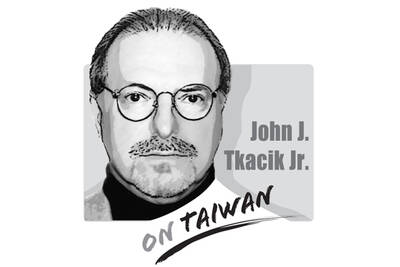President Tsai Ing-wen’s (蔡英文) telephone call with US president-elect Donald Trump has snowballed into a political storm, a development Beijing probably never anticipated. For years Beijing has heavily relied on the US to promote its “one China” policy without realizing how fragile their plan was. Indeed, Taiwanese know full well that they have been used by the US as a bargaining chip against China, yet they also know they can use that to their advantage, which is key to reversing the situation.
Even if China realizes that now, it is still too late because Trump is a typical businessman, not only in terms of his personality, but also his approach: When China seized a US underwater drone on Dec. 15, Trump simply said they could keep it.
From Beijing’s decision to send fighter jets past the median line and into Taiwanese airspace, to fabricated images of a Chinese bomber flying past Yushan (玉山) issued by the People’s Liberation Army and other desperate attempts at saber-rattling, it is apparent that the “one China” principle and the pan-blue camp’s so-called “1992 consensus” are too flimsy to stand up to scrutiny — not even the scrutiny of an incoming US president.
Trump exposed China’s lie like the child in The Emperor’s New Clothes, and like a businessman he tried to use that to raise the stakes for China before negotiating with it.
Trump not only exposed the “one China” lie by talking with Tsai on the phone, he also fixed the US’ relationship with the Philippines with a phone call, relieved tension with Russia by sending his greetings, and made Japanese Prime Minister Shinzo Abe visit him in the US by threatening to quit the Trans-Pacific Partnership (TPP). Nevertheless, is Taiwan truly ready for the big change?
Once Taiwan completely abandons the “one China” principle, what will its economic plan be? Will it improve economic ties with Japan or will it begin talks with the US over a bilateral trade agreement?
One of Trump’s plans is to encourage corporations to move back to the US, which could seriously threaten many companies in China and even cause some to shut down. By that time, the government would have to choose which side to be on. The Tsai administration must be prepared.
This is how Vietnam has managed to attract many businesses from China. Tension between Vietnam and China has risen significantly due to the disputes over the South China Sea. As a result, before his meeting with then-president Ma Ying-jeou (馬英九), Chinese President Xi Jinping (習近平) visited Vietnam, hoping to build bridges between the two countries. However, Vietnam put China in its place by signing a military cooperation agreement with Japan, which led many investors — from the US, China and Japan — to move their capital to Vietnam.
Tsai’s administration must take advantage of Taiwan’s role as a bargaining chip for bigger nations; that is the most effective way a smaller nation can survive. Despite Beijing’s threats, the “one China” policy shall not and would not be Taiwan’s only choice.
Zhang Ming-yo is the director of the Northern Taiwan Society.
Translated by Tu Yu-an

Somehow, US intelligence identified “the Houthis’ top missile guy” and pinpointed his exact location. At 1348 hours (Washington time), March 15, President Trump’s national security advisor Mike Waltz texted, “positive ID of him walking into his girlfriend’s building.” The unsuspecting Romeo entered. High above, the drone monitoring the building registered a flash. When the smoke cleared, Mr. Waltz texted, “…And it’s now collapsed.” RIP. The star-crossed “top missile guy” had been target number one in the now uproarious US Navy bombing campaign on that Sunday against the Yemeni rebels who have been holding the Red Sea hostage since October 19,
China on Tuesday, April Fool’s Day, began two-day joint-force military exercises around Taiwan, painting them as a “severe warning and forceful containment against Taiwan independence.” However, the exercises have again proven the country increasingly showcasing its military muscles to be a true “troublemaker.” Without prior notice, the Chinese People’s Liberation Army’s (PLA) Eastern Theater Command launched large-scale exercises codenamed “Strait Thunder-2025A,” deploying aircraft, drones and naval vessels including the Shandong aircraft carrier, as well as armed militia in the air and waters around Taiwan. The PLA claimed the military exercises were practice for precision strikes and a blockade to “close
Days ago, foreign media reported that Chinese People’s Liberation Army (PLA) Eastern Theater Command Director Lin Xiangyang (林向陽) is suspected to have disappeared under suspicious circumstances. The Eastern Theater Command is the core military department responsible for operations against Taiwan — the purging of its director, if true, would be a major blow to the morale of the Chinese military and the success of its training. On Tuesday morning — April Fool’s Day — the Chinese Communist Party’s (CCP) Eastern Theater Command suddenly announced the launch of joint military exercises in the air and maritime spaces surrounding Taiwan. The exercises
During the four-day Tomb Sweeping Festival holiday, many recall campaigns set up temporary stalls in their electoral districts to encourage more eligible voters to sign second-phase recall petitions. As of Wednesday, a total of 47 recall efforts — targeting 35 Chinese Nationalist Party (KMT) lawmakers and 12 Democratic Progressive Party (DPP) lawmakers — had advanced to the second phase, which requires signatures from at least 10 percent of eligible voters in the constituency within 60 days to proceed to a final vote. Nearly all recall petitions against KMT legislators cleared the first-phase review and launched their second phase between March 8 and